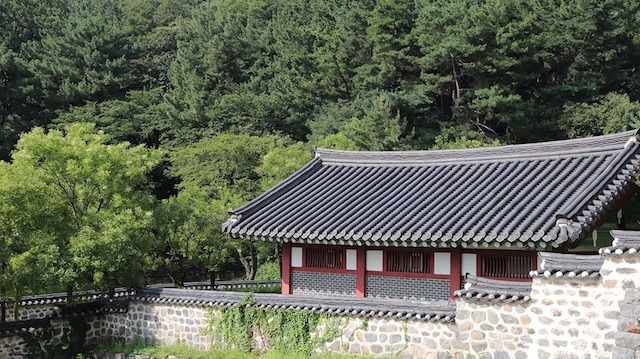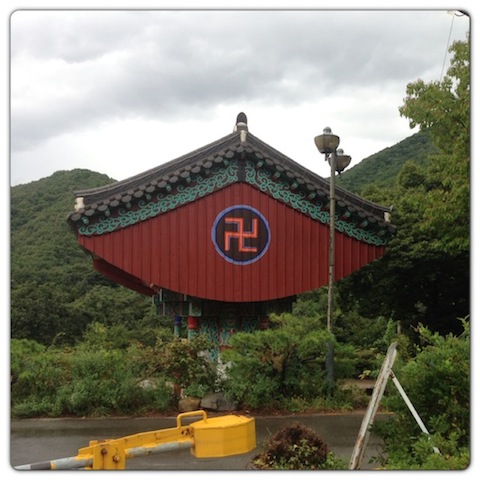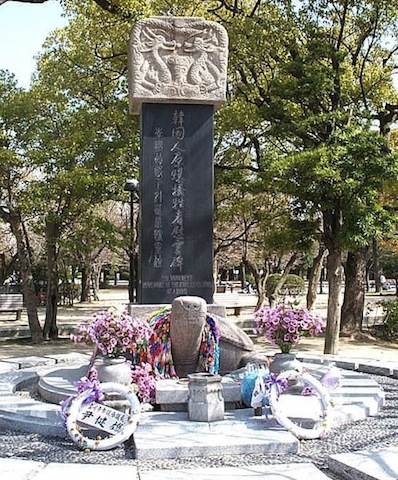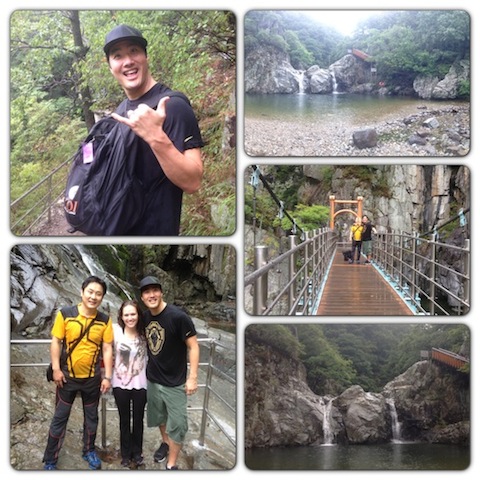On the Changing History of the Swastika in South Korea

A white woman, pushing 40, with a fanny-pack wrapped around her waist and an umbrella tilted back in unison with her neck, gasps at the symbol above her head. It is a giant swastika, painted the color of blood, at the entrance of a historic temple in Pohang, South Korea.
The woman, an obvious visitor from another land, shakes her head and mumbles something incoherent but indisputably interpreted as a sign of condemnation. She continues on her path through the Bogyeongsa Temple, uninterested in getting the story behind the “obscene” symbol.
If the woman had stayed to inquire about the offending emblem decorating the beautifully crafted shrine she might have found out a completely different explanation and than she expected. Long before Adolf Hitler proclaimed the swastika the badge of hate, murder and evil, it was a sign of goodness and peace. The word “swastika” comes from the Sanskrit language and has a literal translation of “it is good.”
The lines of the swastika serve as a symbol for two separate truths intersecting with one another. The horizontal line acts as the symbol of truth remaining eternal for all time and the vertical line means truth for all creatures of Earth.

On the Changing History of the Swastika in South Korea
It is used in many major religions such as Hinduism and Jainism and, in this case, Buddhism. The lines of the swastika serve as a symbol for two separate truths intersecting with one another. The horizontal line acts as the symbol of truth remaining eternal for all time and the vertical line means truth for all creatures of Earth.
The lines are then bent toward each other to create a cycling movement to signify that truth never stops and nothing is permanent. The symbol has existed in East Asia since the Liao Dynasty (AD 907-1125) and is an important and prominent image for Buddhists to this day.
I knew this bit part about history before I visited the temple that day. Yet, I listened again as my husband’s coworker explained as best he could in English about the beauty of the temple and the meaning of the symbol. I’m hard-pressed to find many people of American descent who look upon a swastika with nothing more than disdain and shock. There over 900 traditional temples and over 20,000 total Buddhist temples, swastikas have a very different meaning here in Korea.
The symbol has existed in East Asia since the Liao Dynasty (AD 907-1125) and is an important and prominent image for Buddhists to this day.
This is not to say that Korea was unaffected by World War II as over 25 percent of those murdered by the Hiroshima bomb were Korean. Due to the illegal Japanese occupation of Korea, Japan had started forcing Koreans to take on Japanese surnames and work in places like Hiroshima and Nagasaki. This, in turn, led to countless Koreans falling victim to Little Boy and Fat Man.
My husband and I explored the temple with Mr. Kim, taking in each building quietly. The place called for a sense of calmness and tranquility in each of its visitors. We watched as people prayed in front of Buddha and took refuge under the awnings whenever the rain would start slamming down on us.
On the Changing History of the Swastika in South Korea
I got into a downward dog position and started to meditate, listening to the rain fall down overhead. I heard the quiet mumbles of Rich and Mr. Kim next to me. As I finished, the three of us decided (rain or not) to hike up the landscape and visit the waterfalls that surround the Bogyeongsa Temple.
We traipsed through the mountain, rain slamming into us like buckets of bathwater. The three of us hiked along quietly, taking our time to gaze at each passing waterfall, each one bigger than the one before.
We eventually reached a long wooden bridge that bounced precariously with each step we took. At the end of the bridge was the final waterfall on our journey. It was surrounded by a large pond of aqua-colored water and in its corner, was a hidden cave accessible only to the brave few who try to swim to it.

On the Changing History of the Swastika in South Korea
I ignored the signs warning visitors not to cross the man-made barrier between us and the falls, and I climbed onto the rocks. Suddenly I found myself sinking into a kimchi squat and shutting out all of the other sounds except for the crashing water. Scrawled into the boulders behind me was Hanja, Chinese symbols used within the Korean language, that dated back many centuries.
I closed my eyes and imagined the story that Mr. Kim had told me. For centuries, Korean royals would visit this spot and pray at the falls. Each taking the time to inscribe these sacred symbols into the falls.
I looked up at that swastika one more time and hoped the foreign woman had found as much peace in this beautiful mountain as I had.
After a while, we made our way back through the woods. At one point, Mr. Kim sat down with a group of locals to have a quick drink of soju as Rich and I walked ahead. Back at the temple the rain had let up a bit and the sounds of bells could be heard in the distance. When we reached the exit of the temple, I looked up at that swastika one more time.
I hoped the foreign woman had found as much peace in this beautiful mountain as I had.

On the Changing History of the Swastika in South Korea
Laura Whang is a writer and teacher from Los Angeles. She is currently based in Pohang, South Korea teaching English at both a public elementary school and an orphanage. You can learn more about the changing history of the Swastika and find her at www.BreakingLo.com.
Have you traveled to South Korea? How was your trip? Email us at [email protected] for information about sharing your experience and advice with the Pink Pangea community. We can’t wait to hear from you.
On the Changing History of the Swastika in South Korea photo credits: Laura Whang and pixabay.









Your characterization of those who died by Little Boy and Fat Man as “murdered” is WRONG. The United States didn’t start that war and if you want to talk about murder, tell it to the Koreans, Chinese, Filipinos and the many other nationalities who were BRUTALLY MURDERED by the Japanese. I served in Korea less than 30 years after the war and the hatred of the Japanese by Koreans was evident. My wife was born under Japanese occupation in the Philippines and 22 years after the war, the Japanese were reviled. I know about the religious significance of the Swastika in Korea and appreciate your explanation but keep your opinion about the atomic bombs to yourself. The number of people who died by both pale in comparison to those murdered by the Japanese in their war to dominate Asia.
Nice article and well researched. Combined with a grass roots experience in a very holy place. Let’s drop the Swastika-phobia already.
Buddhist swastiska is almost always clockwise, while the swastika used by the Nazis is counterclockwise.
Also the one used by the Nazis is almost always on an angle.
A beautifully written piece – thank you for sharing.